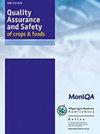介质阻挡放电等离子体对辣根过氧化物酶活性和结构变化的影响
IF 5.3
3区 农林科学
Q1 FOOD SCIENCE & TECHNOLOGY
引用次数: 9
摘要
作为一种新兴的非热技术,冷等离子体已被用于灭活水果和蔬菜中负责酶促褐变反应的内源性酶。本研究旨在研究介质阻挡放电(DBD)等离子体对植物过氧化物酶辣根过氧化物酶(HRP)的失活作用。结果表明,DBD血浆引起HRP失活具有时间依赖性和放电功率依赖性。暴露于57.6 W的DBD血浆2、4、6和8 min后,HRP活性分别下降了32.5%、50.6%、65.5%和75.4%。当放电功率从6.0 W增加到57.6 W时,DBD血浆对HRP的失活效果增强。本征荧光光谱显示,DBD血浆诱导HRP发生明显的结构变化。DBD血浆还引起了HRP的断裂和羰基化以及血红素的氧化降解,这可能与血浆中的活性物质有关。在43.0 W的DBD等离子体暴露8分钟后,HRP的表面疏水性增加了约8.4倍。暴露于DBD血浆后,用原子力显微镜观察HRP的聚集。总之,DBD血浆引起HRP的结构改变和化学修饰,这可能是酶活性丧失的原因。这些数据有助于冷等离子体在食品加工和储存过程中控制酶促褐变的应用。本文章由计算机程序翻译,如有差异,请以英文原文为准。
Effect of dielectric barrier discharge (DBD) plasma on the activity and structural changes of horseradish peroxidase
As an emerging nonthermal technology, cold plasma has been used to inactivate endogenous enzymes that are responsible for enzymatic browning reaction of fruits and vegetables. This study aimed to investigate the inactivation effect of dielectric barrier discharge (DBD) plasma on horseradish peroxidase (HRP), a typical plant peroxi-dase. The results showed that DBD plasma caused inactivation of HRP in a time-and discharge power-dependent manner. The HRP activity decreased by 32.5, 50.6, 65.5, and 75.4%, respectively, after 2, 4, 6, and 8 min of exposure to DBD plasma at 57.6 W. The efficacy of DBD plasma for HRP inactivation was enhanced on increasing the dis-charge power from 6.0 to 57.6 W. Intrinsic fluorescence spectra showed that DBD plasma induced obvious structural changes in HRP. DBD plasma also caused fragmentation and carbonylation of HRP as well as the oxidative degradation of heme, which might be due to the reactive species in plasma. After DBD plasma exposure at 43.0 W for 8 min, there was approximately an 8.4-fold increase in surface hydrophobicity of HRP. After exposure to DBD plasma, the aggregation of HRP was observed by using atomic force microscopy analysis. In conclusion, DBD plasma causes structural changes and chemical modification of HRP, which may be responsible for the loss of enzymatic activity. These data contribute to the application of cold plasma in the control of enzymatic browning of food products during processing and storage.
求助全文
通过发布文献求助,成功后即可免费获取论文全文。
去求助
来源期刊

Quality Assurance and Safety of Crops & Foods
FOOD SCIENCE & TECHNOLOGY-
CiteScore
4.60
自引率
7.50%
发文量
61
审稿时长
1 months
期刊介绍:
''Quality Assurance and Safety of Crops & Foods'' is an international peer-reviewed journal publishing research and review papers associated with the quality and safety of food and food sources including cereals, grains, oilseeds, fruits, root crops and animal sources. It targets both primary materials and their conversion to human foods. There is a strong focus on the development and application of new analytical tools and their potential for quality assessment, assurance, control and safety. The scope includes issues of risk assessment, traceability, authenticity, food security and socio-economic impacts. Manuscripts presenting novel data and information that are likely to significantly contribute to scientific knowledge in areas of food quality and safety will be considered.
''Quality Assurance and Safety of Crops & Foods'' provides a forum for all those working in the specialist field of food quality and safety to report on the progress and outcomes of their research.
 求助内容:
求助内容: 应助结果提醒方式:
应助结果提醒方式:


